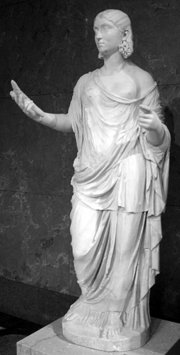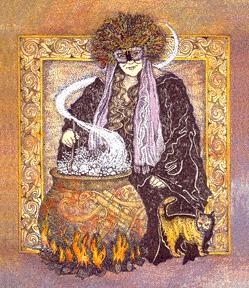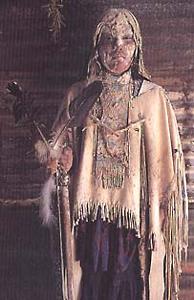


Ceres was personified and celebrated by women in secret rituals at the festival of Ambarvalia, held during May. There was a temple to Ceres on the Aventine Hill in Rome. Her primary festival was the Cerealia or Ludi Ceriales ("games of Ceres"), instituted in the 3rd century BC and held annually on April 12 to April 19. The worship of Ceres became particularly associated with the plebeian classes, who dominated the corn trade. Little is known about the rituals of Cerelean worship; one of the few customs which has been recorded was the peculiar practice of tying lighted brands to the tails of foxes which were then let loose in the Circus Maximus.
She had twelve minor gods who assisted her, and were in charge of specific aspects of farming: "Vervactor who turns fallow land, Reparator who prepares fallow land, Imporcitor who plows with wide furrows" (whose name comes from the Latin imporcare, to put into furrows), "Insitor who sowed, Obarator who plowed the surface, Occator who harrowed, Sarritor who weeded, Subruncinator who thinned out, Messor who harvested, Conuector who carted, Conditor who stored, and Promitor who distributed".
She was depicted in art with a scepter, a basket of flowers and fruit, and a garland made of wheat ears. The word cereals derives from Ceres, commemorating her association with edible grains. The name Ceres comes from the Indo-European root "ker", meaning "to grow", which is also the root for the words "create" and "increase". The asteroid 1 Ceres is named after this goddess, and subsequently a chemical element was named Cerium in turn. Ceres had begged Jupiter that Sicily be placed in the heavens; the result, because the island is triangular in shape, was the constellation Triangulum, an early name of which was Sicilia.
Cerridwen

Welsh Goddess Cerridwen was the keeper of the cauldron of inspiration, rebirth and regeneration. She is the Mistress of the Mysteries, and can be a fierce initiator. Cerridwen brewed a magical potion for her son, to make him the most brilliant and inspired of men. She sent a boy named Gwion to stir and guard the cauldron, and a few drops bubbled onto his hand. Gwion instinctively sucked the burned hand, and instantly all the wisdom and knowledge of the universe was apparent to him. Cerridwen, angered, pursued Gwion as he shapeshifted from one animal to another and finally to a grain of corn, whereupon Cerridwen, who had shapeshifted as well and was now in the guise of a hen, ate him. Nine moons later, Cerridwen gave birth to Taliesin, the greatest of all bards. In him was all the wisdom of his mother's magic. Cerridwen's cauldron is a powerful symbol of transforming magic. The Irish goddess Cerrid gave intelligence and knowledge to humans.
Caillech was the wisest woman. She could move mountains and was thought to be the daughter of the moon.
"Changing Woman"

Changing Woman holds a place of power and reverence in two Native American tribes, the Apache and the Navajo, and her characteristics are similar in each. She represents the turnings of the wheel of time, and at the same time, the eternal timelessness that is beyond and above all such temporal concerns. She is the Goddess of the moon cycles of women, and of the cycles of birth, growth, aging, death, and rebirth. Changing Woman is the magic of the seasons of life and all the wisdom that comes from walking the path of beauty. An Apache woman in the holy ceremony of "ba koh di'yih" is covered with sacred white pollen. She cannot wash off the pollen for the four days of the ceremony without sacrificing her benevolent powers. Nor is she allowed to feed herself or touch herself; if she needs to scratch, she must use a scratching stick. In this ceremony she is enabled to bless the Apache, cure illness, and grant wishes.
Chineke
Chineke is the Ibo creator goddess of Nigeria. She protects those who are good, and punishes those who are evil.
Cronus

Cronus was a Titan god. In order not to be overthrown (as his father Ouranus was by his children), Cronus decided to swallow his own children as they were born. This image depicts his wife, Rhea, presenting him with a stone wrapped in swaddling clothes instead of the infant Zeus to whom she had just given birth. Zeus was raised in secrecy, and he eventually overthrew Cronus, thus becoming ruler of the gods.
More Coming....
